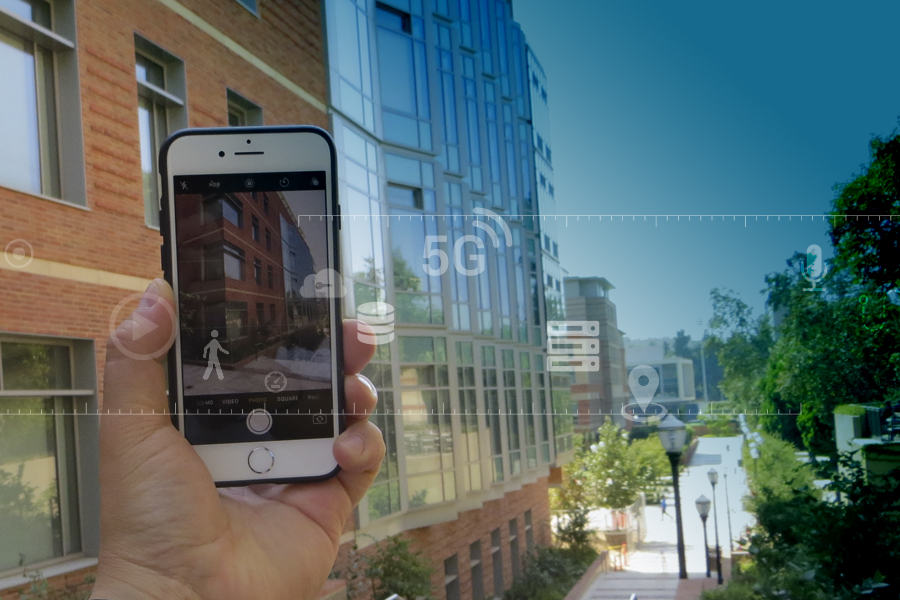
Collaborative wireless networking AR project gets $2 million funding boost from NSF and Intel. Will use Named Data Networking as foundation
A team of researchers from UCLA and New Mexico State University have received $2 million in funding from the National Science Foundation and Intel to integrate augmented reality into new wireless networks. The project aims to develop augmented reality applications on top of the new NDN network architecture to address the limitations in performance, scalability and availability with today’s TCP/IP architecture.
Augmented reality, or AR as it is known, offers a rich, contextual experience on users’ smart phones and other devices. It overlays the real world with data, sounds, video and images from multiple sources to create new wayfinding, education, entertainment, and other experiences as well as new possibilities for industrial, medical, and defense applications. A main hurdle that prevents AR from becoming widespread is the existing architecture of the Internet, which at more than 40 years old, is not ideal for a new way of “browsing the world” through AR: An ideal AR experience is location-specific, individualized for each user, and built from many diverse sources of content in near real-time.
“A fully realized AR environment would not be too far from what science fiction movies have depicted, as many of the necessary components are emerging, including both very high speed wireless technologies and advanced applications such as AR, ” said Lixia Zhang, UCLA’s Jon Postel Chair in Computer Science and the lead principal investigator on the project. “However currently, a major bottleneck in the way is the existing network architecture. We want to use this project to showcase how our newly developed NDN architecture can fully utilize the latest wireless technologies to support AR and promote innovative new applications.”
Today’s internet uses the same protocol architecture that was first developed 40 years ago. Known as TCP/IP, the flow of information depends on the network location of the data. Today’s AR implementations depend on information stored in cloud computer servers, which could be located anywhere in the world. AR could be more readily supported by using a new concept known as information-centric networking, or ICN. NDN is an architectural realization of ICN. So instead of data racing from a building sensor, via servers thousands of miles away to pop-up on someone’s phone close to the sensor, with NDN the phone can directly interact with nearby sensors.
NDN is a new Internet architecture under development by a multi-campus research team led by UCLA. NDN enables devices to directly interact with their surroundings through requesting desired data by names, over any and all available communication channels. For example, imagine an AR application in a museum that lets one engage with interactive exhibits, or one in which first responders are moving through a damaged building. In both cases, the AR applications should be able to access local sensors and other devices through any available wireless channels, without dependence on the Internet infrastructure. Current AR implementations require connecting to Internet servers, which adds both unnecessary delay and dependency on Internet connectivity for an otherwise local data exchange. Instead NDN would keep local communication local, uncompromised by remote failures, in secure, fast and efficient ways.
“In this project, we’re envisioning a new way of browsing the real world in order to drive our research,” said Jeff Burke, associate dean for technology and innovation at the UCLA School of Theater, Film and Television (TFT) and a co-principal investigator on the project. “Imagine your mobile web browser, instead of having some static background, providing a live view into the world through the phone’s camera. Put in a URL and see a media overlay on their real world—from a children’s storytelling environment to a social media application, or a tool for architects, designers, and builders to annotate a job site together. It could also offer real-time feedback that would be immediately helpful to first responders in an emergency.”
The new project that will explore these challenges is called “ICN-Enabled Secure Edge Networking with Augmented Reality” or ICE-AR. It builds on seven years of research from the NSF-funded Named Data Networking (NDN) project , which is a multi-campus research effort and directed by Zhang. Half of the $2 million in funding will come from grants from National Science Foundation , the other half of funding comes from Intel.
The new project has four research goals:
- Build an operational AR demonstration system, an AR campus browser, on an NDN network that runs over high speed heterogeneous wireless technologies.
- Design robust and resilient networking support for AR that can withstand major network failures.
- Transition the delivery of content to one that utilizes in-network storage and processing, is highly individualized, fast, and efficient.
- Incorporate comprehensive security and privacy throughout the system from the start by utilizing the security building blocks provided by the NDN architecture.
Other co-principal investigators on the project include UCLA computer science professors: Songwu Lu and Mario Gerla, both are experts in wireless computing and networking; and Jason Cong, who brings expertise on customizable computing architectures as the director of the NSF-funded Center for Domain Specific Computing. Other co-principal investigators include Alex Afanasyev, a former UCLA computer scientist who recently joined the Florida International University faculty , and Satyajayant Misra, an expert in security and privacy at New Mexico State University who will lead the investigation of the security and privacy challenges in ICE-AR. Burke is also co-director of the UCLA Center for Research in Engineering, Media, and Performance (REMAP), a joint center of UCLA Engineering and the School of Theater, Film and Television.
Also, SCALABLE Network Technologies, of Culver City, Calif., has donated wireless simulation software to the researchers.
